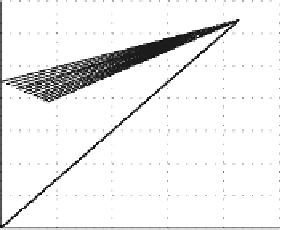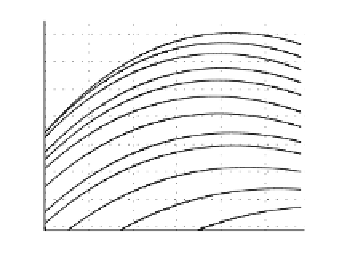Geoscience Reference
In-Depth Information
228
Multiscale Geomechanics
700
0.5
600
0.49
500
0.48
400
0.47
300
0.46
200
0.45
100
0.44
0.43
0
950
1000
1050
1100
1150
1200
600
650
700
750
800
850
σ
1
(kPa)
p (kPa)
(a)
(b)
Figure 8.4.
Stress proportional loading path responses obtained with the octolinear
model [DAR 82] after a triaxial compression at
p
o
= 600 kPa
and
q = 640 kPa
.
R ∈ [−3.5; −2.5]
and with
R
∈ [0.8; 1.2]
it is possible to build the constitutive matrix
S
such as
⎡
⎤
⎡
⎤
dε
1
−
dε
R
−
R
dσ
1
R
dε
2
dσ
1
+ Rdσ
3
dσ
2
− R
dσ
3
⎣
⎦
= S
⎣
R
+
R
⎦
dε
3
[8.16]
R
dε
2
dε
2
Given the static condition [8.14], second-order work vanishes at the
ε
1
− ε
3
/
R − R
/Rε
2
peak. Furthermore the
S
determinant also vanishes because
⎡
⎣
⎤
⎦
=
⎡
⎣
⎤
⎦
dσ
1
0
0
0
R
+
R
dε
3
S
R
dε
2
dε
2
[8.17]
withanon-zerovector
(dσ
1
,dε
3
/R + R
/R dε
2
,dε
2
)
.Hence,itispossibletodefinea
generalized flow rule (called failure rule) according to these mixed conjugated variables
(see [8.17]). Finally, it should be noted that when
R
and
R
are considered to be
variables,
det
S
=0
is equivalent to equation [8.8] [PRU 09c].
To conclude with these aspects, it must be stated that every stress-strain state,
where
N
s
or
M
s
is not positive definite, is included inside the bifurcation domain
and, consequently, unstable loading directions exist. Furthermore, given a particular
loading path, when the second-order work vanishes, it means that a peak does exist for
properly conjugated variables and that a failure rule can be defined for these variables.
Eventually, effective failure takes place only when the variable showing a peak is
controlled. If, on the contrary, the conjugated variable is controlled, it is possible to
pass through this peak without obvious failure. Nevertheless, the loading path after the




































Search WWH ::

Custom Search